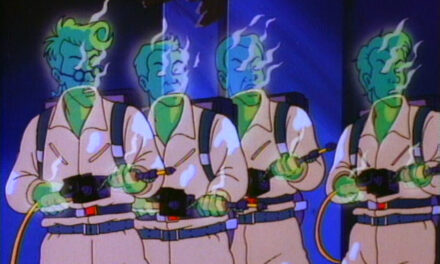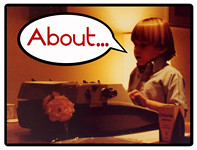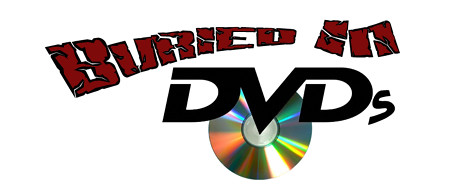
Being that I’m on a sort of super hero kick lately, and since I’ve found a few extra pockets of time to watch some DVDs that have been sitting on the shelf for months, I thought I take a moment to share one of my favorite super hero movies of all time. Now after I’d been into comics for a while, (always a "Make Mine Marvel" kind of kid) and after I’ve fallen into a group of similar minded friends, we would sit around and talk SH movies all of the time, arguing over which was better. Though the original Star Wars trilogy was our bible, super hero films were the next ring of interest and speculation. Of the four of us that hung out together, each of us had our preferable set of Marvel characters: I was into the Punisher and the X-Men, though Wolverine in particular was my favorite, Jeremy was into Spiderman and Namor, though Cyclops was his favorite character, Darrel was an expert on the more fringe characters in the Marvel universe (Cloak and Dagger, The New Mutants, Star Jammers) as well as some indie comics like the Teenage Mutant Ninja Turtles, though he had a pretty strong affinity for Gambit, Kitty Pryde and Night Crawler, and Stephen was the resident underdog lover, covering everything that the rest of us weren’t into like Iron-Man, Daredevil, and the Avengers, though like the rest of us he was partial to an X-Men character, Colossus.
Anyway, while we were comparing and contrasting flicks like Tim Burton’s Batman, TMNT: The Movie, The 1989 version of the Punisher, Superman the Movie, the Flash TV Pilot, Swamp Thing, the 70s-80s Spiderman TV movies, and the 80s unreleased Captain America movie, all of us always neglected to bring up the original pilot movie for the Incredible Hulk TV series. Sure, all of us were familiar with the later TV movies that introduced characters like Daredevil and Thor to the big screen, but I never saw the pilot movie in repeats until the late 90s. In fact I’m not sure if it was ever released on video, and it sure wasn’t released on DVD until the merchandising and publicity started to ramp up for the Ang Lee version in 2003. Universal put out four DVD sets that year, the pilot movie, a really expensive Best Of, and a couple of TV movie collections with the Return of, Trial of, and finally Death of the Incredible Hulk.
Well considering the mass amount of super hero flicks that have been released since ’95, I thought it would be fun to see how this 1977 TV movie held up in comparison. 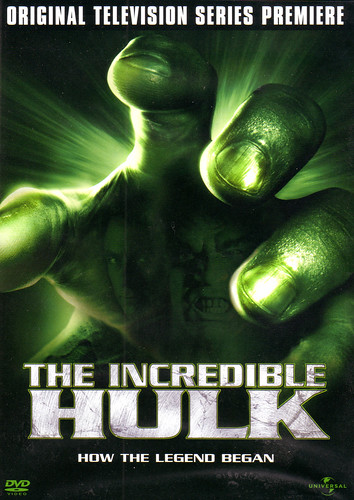
First off, the pilot movie DVD, which might still be available individually (it comes with the awesome 1st season set which also includes commentary on the flick) on DVD, is pretty good for the price. I’ve only ever seen it in $5.50 bins in the various chain stores, so it’s cheap, and in addition to the pilot it also includes the bonus fan-favorite episode Married. The DVD also contains some fluff special features like a sneak peek at the Ang Lee feature film and a decent introduction from Lou Ferrigno (who if you don’t know was the Hulk to Bill Bixby’s David Banner.) 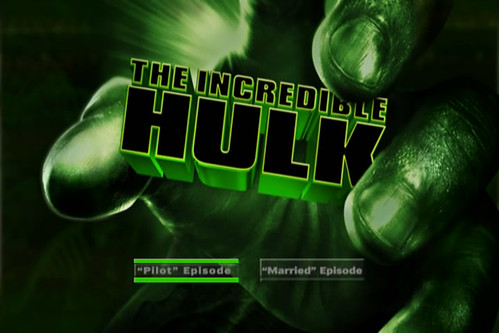
Ferrigno doesn’t get all that much time to reminisce, but he manages to get a few interesting nuggets out about getting the gig, the annoying time in the make-up chair, etc. He’s also very aware of the fan base for the show and he even hits the convention circuit every year taking time to talk with the fans and stuff (unlike a lot of the other "celebrities" who frequent the circuit and are amazingly rude.) 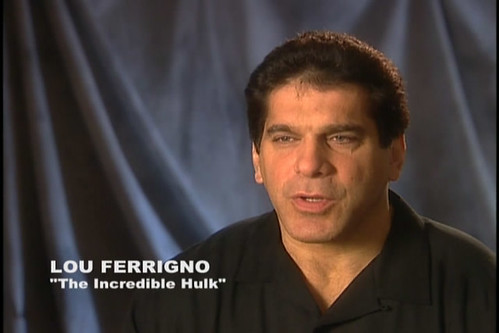
The pilot movie was basically the pitch for the regular series, which was produced, written and directed by Kenneth Johnson the mastermind behind another 80s TV sensation that I was obsessed with as a kid, V. The flick opens up very quietly with a very 70s hazy out-of-focus feel to the text, an effect that makes the flick seem like a bad soap opera more than anything else. It opens with Bill Bixby’s name over the title, and eventually it scrolls to Lou Ferrigno who was more or less an unknown to viewing audiences, but would soon rocket to stardom. 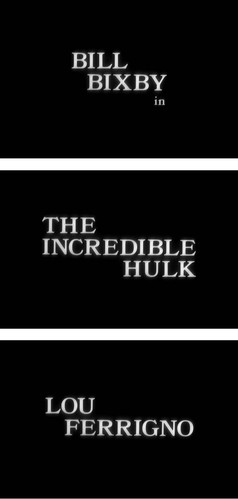
After the credits, the is a quick quote which in a very unsubtle way (completely fitting into the Marvel tradition) lets us know that we are about to see a flick about hidden fury. What’s kind of funny, and what ultimately makes this silly quote work for me is the barrage of imagery that follows. There are approximately six million mini scenes that educate the audience about just how much David Banner and his wife love each other. 
I mean this couple does every stereotypical thing imaginable from walking in flower-strewn fields, to cavorting in the rain, hilariously goofing off while fishing, loving kittens, comforting each other when receiving a sad telegram… 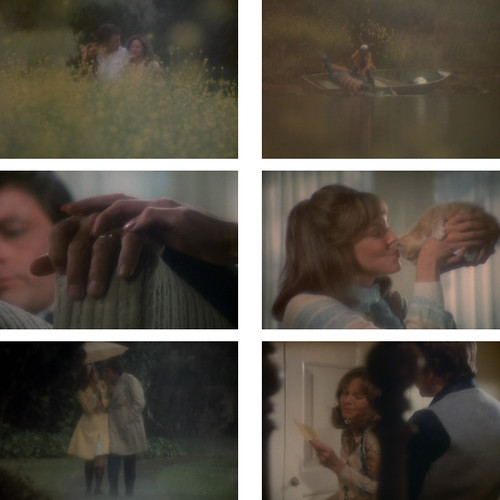
…perfecting their tom foolery while baking, having snowball fights, eating breakfast in bed, lovingly autographing a cast (remember those times of trouble), tailoring each other’s pants (no, seriously, that’s how much he loves her)… 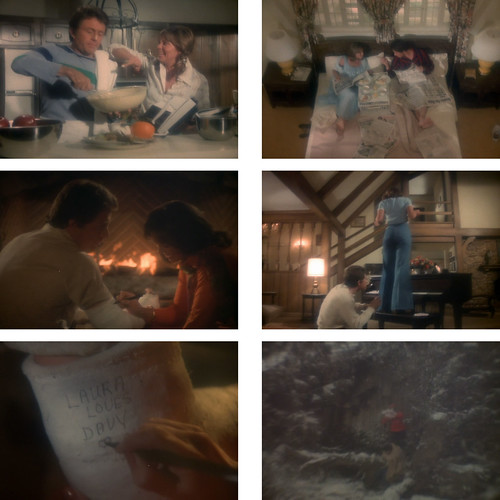
…laying in bed at night (did I mention they love spending time together), and walking through more fields of flowers. It was about this point when I seriously considered shutting off the film (actually it was during the un-pictured "we-love-each-other-so-much-we-went-disco-dancing" scene.) I mean, hit me over the head why don’t ya. Jeez, where was the playful swimming at the beach scene, or the post coitus afterglow-hugging scene, huh? Anyway, the movie takes a very ironic turn for the better when the couple climbs into their car and some very foreboding piano music starts playing in the background. As much as I hate to see people in pain and suffering, this movie needed to get off the Hallmark "I love you ever so much" train and back on track to being a super hero flick. 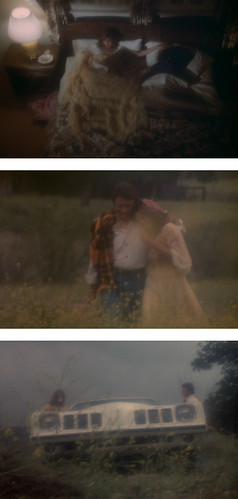
It’s at this turn where the movie really starts becoming interesting, and it sets a tone for the rest of the film that I think works amazingly well and is something absent in most super hero origin movies from that point on. In this last opening sequence the audience witness the tragic car accident that leads to the death of David Banner’s wife as well as his pent up aggression and rage that will propel him in becoming the Hulk.
Real quick I’d like to make it clear that I am going to spoil the hell out of the story and sequences of this film, so if you haven’t seen it and want to be surprised, you might want to ditch this trip down nostalgia road. 
Anyway, during the accident, when the car is flipping out of control, David Banner is flung from the vehicle. The car bursts into flame and as he struggles to try and get the door open and his wife out, but it’s impossible no matter how hard he kicks or pulls. It’s a very disturbing scene and does a very good job of putting the audience in the character’s place, frustrated with the flame spreading everywhere. Just as the character reaches his breaking point he wakes up from what we now know is a reoccurring dream he’s been having since the incident. This is where the casting of Bill Bixby really pays off in this film. Bixby was an amazing dramatic actor and he completely owns the role of Banner. One thing I was super glad about from a technical standpoint was when Banner awakens from the dream the whole hazy, out-of-focus, Vaseline on the lens effect stops, which is very dated and annoying. This type of overbearing visual cue really gets on my nerves, as it doesn’t trust me to make the connection that it was a dream. I mean, having Banner wake up is quite enough; you don’t need to do any more work than that. 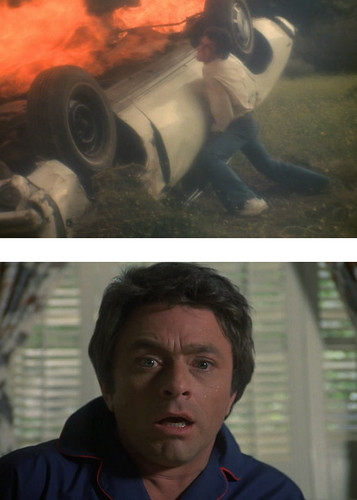
Another thing to note is that right from the start, Johnson has made major changes to the mythos of the Hulk universe, yet most of the changes are perfectly natural and help to ground the character in a reality that the comics don’t need. The character from the comics, though he has some repressed issues with his father, didn’t really have a tragic incident like this to put him in the mood of the piece. As we see in the next set of scenes, Johnson also chose to change the character’s name from Bruce to David, as well as switching him from being a nuclear scientist to a doctor studying the untapped resources of the human body. I’ll be honest, it’s changes like this that typically get my fanboy fur to stand on end, but in this film most of the changes help bring the character to life in a much more natural and less coincidental way. Whereas in the comic Banner is pelted by a mass amount of gamma rays in a weapons testing accident, in this film it’s worked into the story and becomes more of a deliberate act. The one change that I can take or leave is the name change. I believe Johnson decided to switch it to David because he didn’t care for alliterative names (which are Marvel and DC specialties), but he also reportedly made the change because he felt that Bruce was too "gay" of a name (which I think is a rumor that Stan Lee started on that interview DVD he did with Kevin Smith.)
Anyway, the story continues by introducing Dr. Elaina Marks, Banner’s research partner, who together are searching for the untapped source of strength that some people seem to hit upon during times of high stress or tension. They interview a series of people including a mother who saved his son from a car accident that mirrored Banner’s accident to a T. The duo keep hitting a wall though as they can’t seem to find any common links between the subject outside of the fact that they all had a traumatic experience. 
It’s at this point that we’re introduced to a very (now) common super hero movie trait, which is looking to very realistic scientific explanation for super heroic powers. In most cases, this film included (and it may be the first film to explore this), this means getting deep down into the DNA, up to including a sweeping shot where the audience is taken on a ride into a person all the way down to one individual DNA strand. You see this in two of the the Spiderman movies, the X-Men flick, the Ang Lee Hulk film, and some of the super hero TV series as well I think. It’s just a very common visual effect, and one that’s very effective as we live in a world that is so DNA-centric what with the various crime scene investigation shows, flicks like Jurassic Park, paternity tests, and the possibility of cloning and designer babies right around the corner, DNA is pretty much the most iconic representation of body science imaginable. 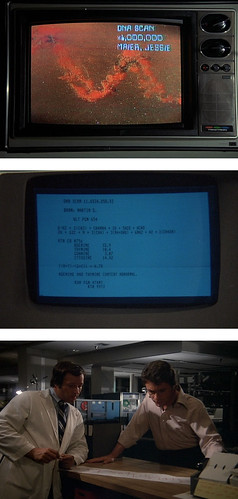
Well, in a breakthrough, the couple figures out that in all of the cases they’re investigating, all of the subjects have an odd DNA signature that is abnormally high in adenine and thiamine. This leads them to testing Banner’s DNA, which in true super hero form is not only abnormally high in these same elements, but much more so than the rest of the subjects, which only adds to the frustration that Banner is having with losing his wife. Why couldn’t he tap into this power and save his wife? Though Elaina packs it in for the night, David can’t let it go and continues to search for something that would point to why this abnormality might produce excessive strength. He stumbles upon an idea as he’s talking to a fellow scientist about gamma radiation activity from sunspots, and matches up the time line on the subject’s increased strength to sunspot activity and high levels of gamma radiation.
This is where the film’s slow build begins to pay off for me. In the comic, and in most comic stories and movies, there is one quick incident, usually an accident that requires a jump in logic to buy the fact that a character has gained monumental new powers. Be it Peter Parker getting bitten by a radioactive spider, Matt Murdock having toxic waste flung into his eyes, or Bruce Banner running out to save a friend during a gamma bomb test (man, I see Johnson’s point on the alliterative names), there usually seems to be a coincidental accident that results in powers that are unbelievable (though in a good way.) When Banner realizes that the key the hidden strength lies in exposure to gamma radiation it’s a much more natural conclusion when he decides to test this theory out on himself. 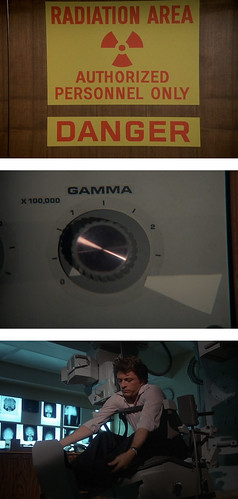
Something else I really love about this film and its realism is probably the side effect of being filmed on a TV budget. It looks like a real laboratory was used in these scenes, or at least some real equipment, and it’s completely non-flashy. When Banner doses himself with the gamma rays it’s silent and invisible, much like getting an x-ray. For all of it’s non-flashiness, it’s still a very effective an haunting scene filled with much of the iconic imagery that would eventually make up the opening credit sequence of the TV show, from sitting the in the contraption to the x-ray of David’s skull. 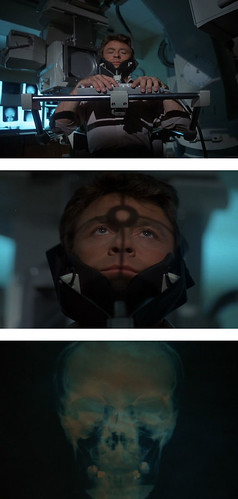
It’s in this sequence that the camera travels deep into David, so deep that it gets down to his DNA in a very effective sequence, which makes it out to look like tiny glass beads and bubbles, a much more detailed sequence than the movie lead me to believe it would get. It’s also here where the accidentally over dosage that Banner gives himself is revealed (which was foreshadowed in a previous scene in which Elaina mentions that most of the research equipment had been upgraded, which is why new tape marks have been added to consoles, effectively showing that the makings can go up to 11.) 
For me this is when the movie shines as in the next few scenes we see the build-up of anger that David is suffering from. After the gamma dosage, Banner is unable to lift anything heavier than normal and again he is frustrated as he hits another wall in the research. On the way home he gets stuck in the rain, has troubles starting his car, and then blows a tire after running over some road debris. There’s a slow burn as he gets out to take care of the flat, hurting himself getting the spare out of the trunk, fumbling with the jack in the rain, and then hurting his hand as it slips off the tire iron. This all just builds and builds in a very natural and understanding way (we’ve all had days like this.) This finally hits a crescendo that pays off in David’s first transformation into the Hulk, an effect that could make or break the movie. The effect is pretty astounding, beginning with the tinny high-pitched hum where David flicks open his eyelids to reveal that his irises have turned a light greenish-white, and is then followed by a barrage of quick edits showing his features changing, his muscles bulging out and ripping his sleeves, his shirt ripping up the back and eventually his unnaturally green skin. This first transformation is done flawlessly and is really beautiful, even when compared to the advanced effects work today and is the perfect illustration of how you don’t need a ton of CGI to do really effective and believable effects work. 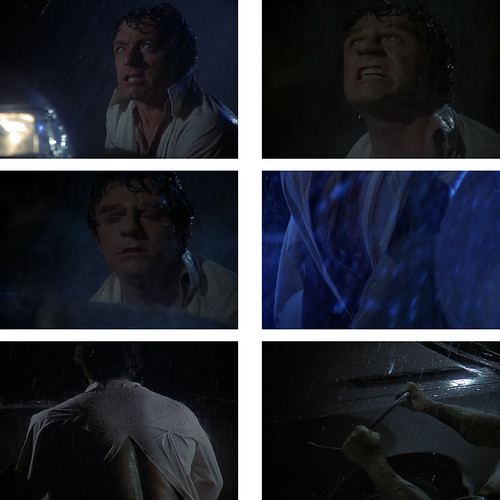
There’s a great moment as the camera pulls back and shows the Lou Ferrigno as the Hulk for the first time in the pouring rain and then is highlighted and illuminated by a lightning strike which is helped along by the great orchestrated score. When then get to see David let out all of the tension that’s been building (through the slow first half of the film) on his car as he pounds on the hood with both fists clenched. 
This whole sequence where he thrashes his car, smashing the windows, ripping off his flat tire and flinging it into a nearby ditch is all very exciting and fun and culminates in the Hulk picking up and flipping the car into the ditch where it explodes very unrealistically, but at this point realism doesn’t matter as much as the audience has bought into the concept. That’s the first major strength of this film, that the first half is gruelingly realistic, it totally sets up the transformation scene. The second strength of the film is that there is no set up for a villain that the Hulk will fight. By this point in any other super hero movie there’s usually a very obvious and awkward villain built up and in place for the final showdown sequence. It’s a cliche that I really don’t care for, and something that I think should be left for a sequel. This flick completely sidesteps the villain angle. 
It’s at this point where Johnson starts playing with the character. He’s basically set up with the back-story straight out of one of the Universal monster movies, so Johnson playfully homages the little girl and the lake sequence from Frankenstein. The Hulk confused and dazed wanders through the woods until he stumbles upon a little girl fishing at the edge of a lake and just like Frankenstein he scares the living piss out of her. Unlike Frankenstein the Hulk doesn’t hurt the girl, instead she gets herself into trouble paddling out into the water in her canoe and then falling overboard. As the Hulk tries to save her, her father comes back from hunting and ends up shooting Banner in the arm. This is when Johnson decides to hammer home the point that his version of the Hulk will not kill or really even hurt innocent people (or villains for that matter) and instead of "Hulk smashing" the dude, he takes the gun, breaks it, and then throws the dude into the lake with his daughter. 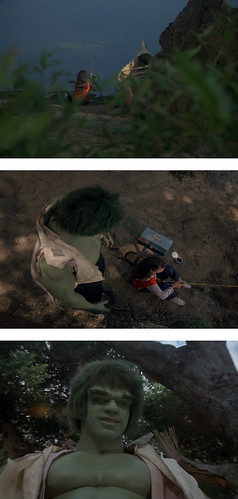
There’s another really strong scene here where Johnson films the Hulk from over the shoulder as the Hulk stoops by the lake and sees his reflection for the first time. In this moment of calm Banner slowly changes back to himself in a series of edits that are cut between the character reaching out to touch his reflection in the water, a very nicely executed and creative effect. 
It’s at this point that the film goes full force into only exploring the Hulk’s origin as Banner flees to his friend and colleague Dr. Marks, and together they try to understand this crazy situation. They retreat to a deserted portion of the research facility they work at which houses a pressure chamber that Banner hopes will hold the Hulk if he ends up changing again. The movie reverts back to its plodding pace, but honestly it’s a very welcome deviation to the over-produced frantic pace that most super hero films follow today. The two try to recreate the transformation inside the chamber, going so far as to artificially make it rain and lightning, but try as they might they can’t do it. Then hours later, Banner decides to rest, and during another episode of his reoccurring nightmare where he once again powerlessly has to relive his wife’s death, he unconsciously begins the transformation into the Hulk. Even though the chamber is constructed with thick metal lining and six inch thick glass, the Hulk still manages to smash and break his way out where he confronts Elaina, but once again we see as the Hulk isn’t just violence incarnate, but human bound by his alter ego’s morals. 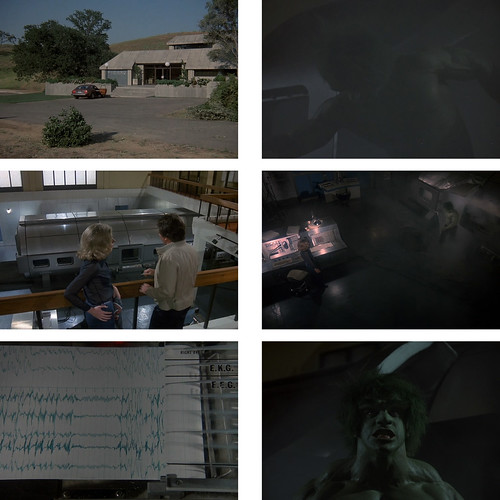
Again, Johnson makes homage (though a little more heavy handed) to another monster, one a little more close to home, Dr. Jekel and Mr. Hyde. Unlike Hyde the Hulk isn’t evil or a beast derived from all of the hidden carnal instincts of man, but merely a physical manifestation of anger, frustration and rage. He won’t hurt Elaina, in fact he even obeys her much like a dog. She also has enough of a calming effect on the creature that he slows down enough to revert back into Banner. 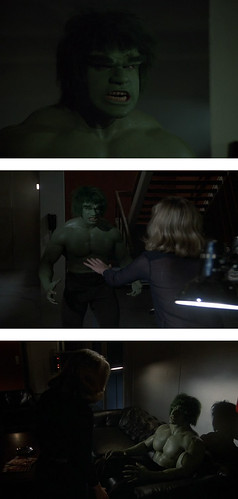
This time, unfortunately, the effects work doesn’t shine and is very dated with a cut-out segment of film that flashes between various versions of Ferrigno and Bixby, overlaid with a very odd green light that just services to make the transformation all the more awkward. Buried within this though is a very awesome bit of subtlety where Bixby has the white contacts in, he closes his eyes, and in an imperceptible cut, opens his eyes and the contacts are gone. It’s funny how you can have all ranges of quality in the effects work within one shot like that. 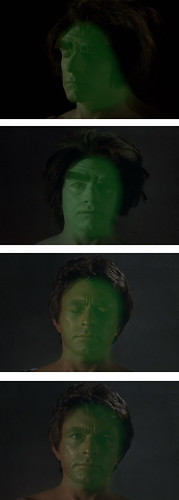
Another thing that this movie does very well is to introduce story threads that are left in the background until later, which makes the story seem more over arching that it might really be. At the beginning of the film we are quickly introduced to Jack McGee a reporter for a crappy tabloid that’s trying to score an interview with Banner or Mark about the work they’re doing on hidden strength. Well, he pops up again towards the end, though this time he’s more interested in the sightings of the Hulk and it’s connections to Banner who he was already pursuing. Here again Johnson makes allusions to monsters, this time to Bigfoot, and places McGee in the role of the monster hunter. 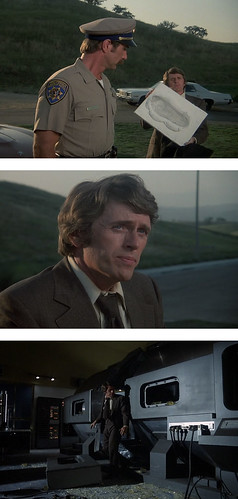
Johnson uses McGee as a catalyst that will set up the continuing TV series later on in a move that it a little bit of a groaner, but not so bad now that most of the movie is dedicated to discovering the understanding the Hulk. There is an accident after McGee breaks into the lab where Banner last turned into the Hulk; he’s hiding in a closet listening to Banner and Mark when he’s discovered and then knocks over a jug of a highly reactive chemical. As Banner escorts McGee out of the building the chemical reacts with another substance causing a drastic explosion with Dr. Mark trapped inside. 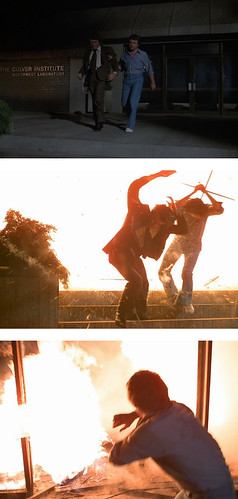
Banner, reacting to the incident, turns into the Hulk and rushes into the building to save Elaina. He manages to get her outside and into the nearby woods (where McGee sees the Hulk carrying her) but she’s badly hurt and ends up succumbing to her wounds. Before she passes she tells Banner as the Hulk that she loves him, which is heart breaking as Banner doesn’t remember much that happens during the hulking out episodes. This is another story thread that is carried throughout the show as Banner is never sure whether or not he killed her, and always carries this guilt around with him. 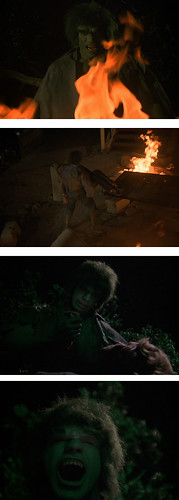
The film ends with a funeral for both Banner (who was thought to have perished in the facility fire) and Elaina. There’s a fun nod to the character’s original name (Bruce is now David’s middle name, which is actually the same as in the comics, the character is Robert Bruce Banner) on his headstone. As the mourners slowly drift away Banner emerges and pays his last tribute to Elaina, illustrating his remorse and guilt (also mentioning that he loved her and thinks she did too), and then he turns and walks away with his backpack slung over one shoulder, and to the tune of Super Heroes (from the Rocky Horror Picture Show) in a scene that would be repeated at the end of every episode of the show. 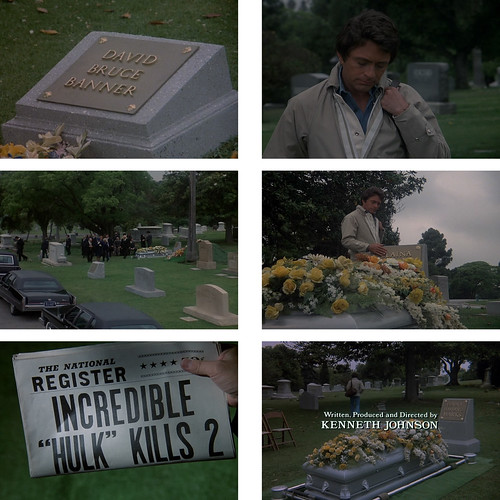
After I was done watching this I was surprised how much I really ended up loving this movie. I wish that other super hero movies would take the time to tell a well-crafted story like this and do it at a pace that is right for the story and not what the audience expects. Hell after watching this, I wish Bryan Singer had, had the guts/clout to go ahead and completely nix the Lex Luthor plot line from Superman Returns, instead focusing on the characters and the love story. I’m sure it would have pissed off a bunch of people (I mean the ones that the film didn’t already piss off) but it would have been bold and satisfying (at least for me.) I guess I’m sick of every single super hero film having to be an action film first and then a good story second. I know it’s a convention of comics and all, but there are other stories to tell. Astro City is a great example of a comic that tried to defy these conventions, at least partially and tell other types of super hero stories, from other perspectives (like a regular Joe watching this craziness from the street.) The Incredible Hulk does this really well for me. It might be boring for others, but oh well.
As a P.S., there was one change that Johnson wanted to make from the comics that I’m glad didn’t happen. He wanted the Hulk to be red to mirror the anger that the character was suffering from. Man, though would have totally negated everything I said above and would probably have been a fanboy nitpick that completely took me out of this film (much like the absence of the Punisher skull was for the 1989 version, which up until just recently made me hate that film.)


